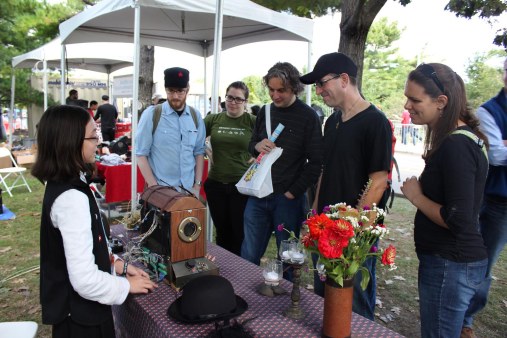An exotic parlor amusement retrieved from an imagined past
Winner of two Editor’s Choice Blue Ribbons at World Maker Faire 2012!
The Musiquarium was the second major invention of Grommet Labs, (following the Slugophone, which we introduced a year earlier), and was our second project accepted into the World Maker Faire. Our idea was to give water creatures a voice by allowing them to make musical tones as they triggered infrared sensors. As the goldfish wandered around the tank, they swam in front of various sensors—and when they did, each one produced a different sound.
We originally thought of the Musiquarium as a way to build on the idea of the Slugophone—a device that explored the interface between humans and animals, music and noise. The idea of a project that harmlessly involved live animals creating or “finding” musical sequences was the topic we were most interested in. And so we began to plan and construct the Musiquarium.
We started with a small square fish tank from a pet store, and fitted a metal case around the bottom where the circuit was going to go. For its design, we employed the steampunk theme we had used with the Slugophone. Our idea was to create an aquascape evoking the remains of a crashed airship, with fragments of debris intertwined with fantastic coralline growths. The infrared sensors were then put into the tank, hidden among the decorations and gravel.
The sensors were triggered by invisible infrared light, provided by a bank of IR LEDs above the water. Some sensors were designed to produce a musical tone when a fish swam over them and blocked their light; others reacted to reflected light bouncing off the fish’s shiny scales. When a sound was triggered, an LED would light on the front of the Musiquarium; the sensitivity could also be adjusted, allowing us to “tune” the instrument. (Chris talks more about the circuit here).
The sounds triggered by each sensor were chords produced from a toy piano we picked up from a thrift shop and lovingly dissected. The toy piano also had settings for different “instruments” including bells, saxophone, xylophone, and more. We enabled the Musiquarium to produce those various sounds, as well as routing the chords through an echo delay. After two and a half months, the Musiquarium was finally completed just in time for Maker Faire 2012.
The Musiquarium was a success. Visitors seemed to love it, and many stayed to hear the sounds and tune the instrument themselves. Reporters interviewed us and made videos of the machine in action—Juliana even had a sound bite on NPR’s Morning Edition radio show. Some people said they enjoyed it because it was one of the only exhibits that involved live animals. Others asked if they could buy it. We were proud to win two Editor’s Choice blue ribbon awards at the 2012 World Maker Faire. After the excitement was over, we returned to schoolwork and regular activities, all the while thinking about another project for next year.




Reblogged this on agritechblog.